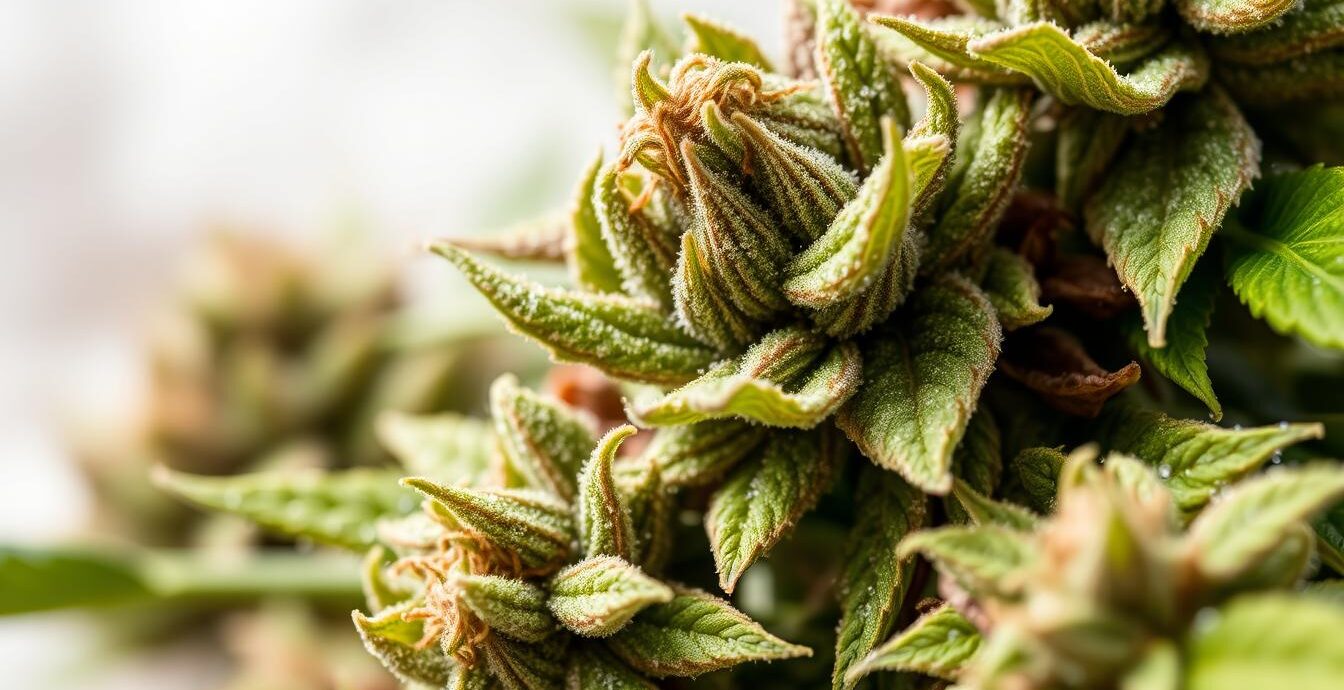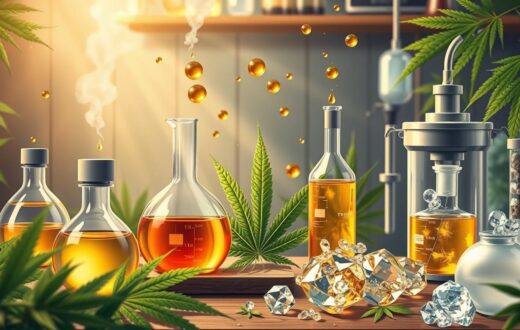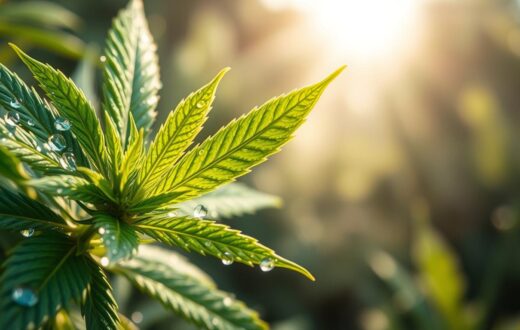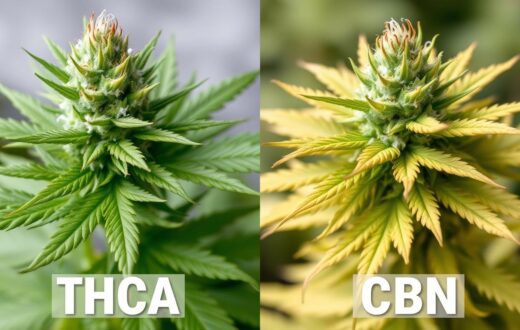Have you ever wondered about the hidden power in raw cannabis flower? Many think of cannabis as just a psychoactive substance. But there’s a compound called THCA that’s making waves. Tetrahydrocannabinolic acid, or THCA, is found in fresh cannabis and offers benefits without the high.
THCA in raw cannabis is getting attention for its health benefits. Unlike THC, THCA doesn’t make you feel high. It’s found in high amounts in fresh buds, making raw cannabis a unique source of wellness.
Studies show THCA might help with inflammation, protect brain cells, and reduce nausea. A study on rats found THCA could lessen nausea better than THC at lower doses. Another study in 2017 showed THCA’s potential in protecting brain cells.
Exploring THCA’s benefits in raw cannabis is key. This compound is legal in many places where cannabis isn’t. Hemp, with less than 0.3% THC, often has THCA and is widely available. This opens up new possibilities for natural wellness without legal worries.
Understanding THCA: The Non-Psychoactive Compound
Cannabis plants have many cannabinoid acids, like tetrahydrocannabinolic acid (THCA). This compound is in raw cannabis and has benefits without the high of THC. Let’s look at THCA and how it’s different from THC.
What is THCA?
THCA is a phytocannabinoid in raw cannabis. It’s the precursor to THC but doesn’t cause a high. It’s made when the plant breaks down cannabigerolic acid (CBGA), the mother of all cannabinoids.
How Does THCA Differ from THC?
THCA and THC have different molecular structures. THCA has an extra carboxyl group, which stops it from binding to brain receptors. This is why raw cannabis doesn’t get you high. When you heat it up, like smoking or cooking, THCA turns into THC.
THCA might have health benefits without the high. It could help with inflammation and protect the brain. You can eat THCA by juicing raw cannabis leaves or adding them to smoothies. More research is needed to understand its full potential.
The Role of Raw Cannabis in Health and Wellness
Raw cannabis flower is full of health benefits. Growers focus on keeping the plant’s natural compounds. These compounds are good for us when we eat them raw.
Nutritional Value of Raw Cannabis
Raw cannabis is full of nutrients. It has vitamins, minerals, and fiber. It’s also rich in phytocannabinoids, like THCA, which may help with inflammation and stress.
How to Incorporate Raw Cannabis into Your Diet
It’s easy to add raw cannabis to your meals. You can juice the leaves for a healthy drink. Or blend it into smoothies for a boost of phytocannabinoids.
Chopped leaves are great on salads or in wraps. Start with a little and add more as you get used to it.
Raw cannabis doesn’t get you high. The THCA in it turns into THC when heated. So, you get the health benefits without the psychoactive effects. Make sure to buy from growers who use clean methods.
Therapeutic Properties of THCA
THCA is a cannabinoid acid found in raw cannabis. It has many potential health benefits. This compound is rich in fresh cannabis plants and is part of the phytocannabinoids group.
Anti-Inflammatory Effects
Research shows THCA may reduce body inflammation. This could help those with arthritis or Crohn’s disease. Unlike THC, THCA doesn’t cause a “high,” making it good for those seeking relief without psychoactive effects.
Neuroprotective Benefits
THCA might protect brain cells. Studies suggest it could help with neurodegenerative diseases. Its neuroprotective quality makes it unique among cannabis compounds.
Potential Antiemetic Properties
THCA could help reduce nausea and vomiting. Some studies say it’s more effective than THC at lower doses. This makes it interesting for cancer patients undergoing chemotherapy.
Research on THCA is still early, but its potential benefits are promising. As we learn more about phytocannabinoids, we might find new uses for cannabis.
The Science Behind THCA
THCA is a compound found in raw cannabis. It doesn’t make you high because it’s non-psychoactive. But, when heat is applied, something magical happens.
This process, called decarboxylation, turns THCA into THC. THC is what gives cannabis its famous effects.
How THCA is Converted to THC
The change from THCA to THC is a big part of how cannabis works. When you smoke or vaporize it, heat does the trick. But, it’s not just heat.
Light and air can also change THCA to THC over time. That’s why keeping cannabis in the right place is important.
The Importance of Decarboxylation
Decarboxylation is key to unlocking cannabis’s full power. It happens at temperatures between 230-250°F for 30-40 minutes. This isn’t just for getting high.
It’s also vital for activating many of cannabis’s health benefits. Without decarboxylation, you miss out on a lot of what cannabis can do.
Knowing about this science helps us use cannabis wisely. Whether you want the benefits of THCA or THC, understanding how they work is crucial.
Legal Status of Raw Cannabis and THCA
The laws on raw cannabis and THCA in the US are complex. Different types of cannabis face different rules in each state. The 2018 Farm Bill made it legal to sell hemp products with less than 0.3% THC, including THCA. This move helped scientists study how cannabinoids are made and led to new discoveries.
Cannabis Legislation Overview
At the federal level, THCA is seen as a Schedule I drug because it can turn into THC. The DEA is looking into changing this classification to Schedule III. This could make it easier to use cannabis for adults. However, a new proposal in Congress could ban certain hemp products, including THCA.
States with Legal Raw Cannabis Products
State laws on raw cannabis vary a lot. California and Colorado are ahead, allowing the sale of THCA flower as long as it follows Farm Bill rules. Pennsylvania lets people buy THCA flower but has strict rules on processing and selling hemp products. Texas limits the sale of THCA flower to prevent it from becoming psychoactive THC.
It’s important for buyers to check local laws before getting THCA products. Brands like CBD Mall and Chill Cloud offer popular strains like Gorilla Glue #4 and Sour Diesel. These products are great for juicing or adding to smoothies.
Methods for Consuming Raw Cannabis
Raw cannabis flower is special because it has lots of phytocannabinoids, like THCA. Growers work hard to get these compounds in the plant. Here are some fun ways to enjoy raw cannabis without getting high.
Juicing Raw Cannabis Leaves
Juicing raw cannabis leaves keeps THCA in your drink. Mix it with fruits or veggies for a healthy drink. This way, you get more cannabinoids without feeling “high.”
Incorporating Raw Cannabis into Smoothies
Adding raw cannabis to smoothies is a yummy choice. Blend it with fruits, veggies, and liquids. It hides the plant’s taste while giving you phytocannabinoids’ benefits.
Culinary Uses of Raw Cannabis
Raw cannabis can make food better. Sprinkle chopped leaves on salads or use them as a garnish. Some people even eat raw cannabis buds for health reasons. Raw cannabis won’t get you high, so it’s great in cooking.
By eating raw cannabis, you get to enjoy its full benefits. Whether you juice, blend, or cook it, these methods let you experience cannabis’s good side without the high.
Potential Side Effects of THCA
THCA, a cannabinoid acid in raw cannabis, has promising benefits. But, it’s important to know its possible side effects. Unlike THC, THCA doesn’t get you high, but it can still affect your body.
Understanding Dosage and Its Implications
Using THCA can cause mild discomfort. Some people feel dizzy, have dry mouth, or feel a bit nauseous. Taking too much THCA might make you sleepy, change your appetite, or affect your blood pressure.
It’s key to start with small amounts and watch how your body reacts. This way, you can avoid any unwanted effects.
Using THCA over time could have bigger effects. Studies show it might affect your brain and breathing if smoked. Teenagers might feel more side effects, like memory problems and trouble focusing.
Common Misconceptions About THCA
Many think THCA is never psychoactive. But, that’s only true when it’s raw. When heated, like when smoked or vaped, THCA turns into THC. This means THCA products can make you feel high if not used right.
Some also think THCA is legal everywhere. But, while THCA with less than 0.3% THC is legal in the US, laws vary by state. Always check local laws before using THCA products. Remember, how THCA affects you can change based on the cannabis type, affecting side effects.
Comparative Benefits: THCA vs. THC
Cannabinoid acids are key in the cannabis plant. Tetrahydrocannabinolic acid (THCA) and THC are two important phytocannabinoids. THCA, found in raw cannabis, offers benefits without the high. THC provides pain relief and appetite stimulation but has psychoactive effects.
When to Choose THCA Over THC
THCA is perfect for daytime use or for those avoiding intoxication. It doesn’t interact with CB1 and CB2 receptors like THC does. This makes THCA a great choice for users seeking benefits without cognitive impairment. THCA flowers can have up to 40% THCA, offering more flexibility than THC flowers.
The Synergistic Effect of Cannabinoids
The cannabis plant has various phytocannabinoids that work together. This synergy enhances the overall effects of cannabis. THCA interacts with the TRPA1 receptor, while THC binds directly to CB1 and CB2 receptors. Some users may benefit from combining these cannabinoids for a more comprehensive effect. Research into cannabinoid acids continues, with promising findings on THCA’s neuroprotective qualities.
Understanding the difference between THCA and THC percentages is key when choosing cannabis products. Multiply the THCA percentage by 0.877 to estimate potential THC content after decarboxylation. Remember, legal status varies by state, so always check local laws before use.
Research and Studies on THCA
The study of cannabinoids is growing fast. Scientists have found over 125 different types in cannabis plants. THCA, a non-psychoactive part of cannabis, is being studied for its health benefits.
Current Clinical Trials
Researchers are looking into THCA’s effects on many health issues. They’re studying its anti-inflammatory and neuroprotective properties. One study found it might help with Alzheimer’s disease in mice.
Prominent Studies on THCA’s Benefits
Recent studies highlight THCA’s special qualities. It doesn’t make you high like THC does. This makes it good for those who want health benefits without feeling intoxicated.
Studies show THCA might help with nausea, metabolism, and seizures. Hemp plants, with less than 0.3% THC, are often used in these studies. Scientists are also learning how heat changes THCA into THC.
More human trials are needed, but early results are encouraging. As research continues, we might find more ways THCA can help in medicine. This could open up new uses for cannabis in treating diseases.
The Future of THCA Research
The cannabis world is buzzing with excitement about THCA research. This non-psychoactive compound found in raw cannabis plants is drawing attention from scientists and medical experts. As we dive deeper into cannabis science, we’re uncovering new possibilities for THCA in healthcare.
Areas of Exploration in Cannabis Science
Scientists are focusing on cannabinoid biosynthesis to understand how plants create THCA. This knowledge could lead to new ways of producing this beneficial compound. Research is also looking at different cannabis chemotypes to find strains rich in THCA. These studies aim to maximize the potential of various phytocannabinoids for medical use.
The Potential for THCA in Medical Treaties
THCA shows promise in treating several health issues. Its anti-inflammatory and neuroprotective properties make it a candidate for managing neurodegenerative diseases. Some studies suggest THCA might help slow the growth of certain cancer cells. As research progresses, we may see THCA included in medical cannabis treatments for a range of conditions.
The future of THCA research looks bright. As we learn more about this compound, we’re opening doors to new treatments and therapies. The cannabis plant continues to surprise us with its potential to improve health and wellness.
Cultivating Raw Cannabis for THCA
Growing raw cannabis flower rich in phytocannabinoids needs skill and knowledge. It’s all about making the most of the plant before it loses its THCA. This is key to successful cannabis cultivation.
Choosing the Right Strains
It’s important to pick strains with lots of THCA. Growers look for genetics that are known for high THCA levels. These strains take 8-16 weeks to flower, which is when THCA production really goes up.
Best Practices for Growing Raw Cannabis
For growing THCA-rich cannabis, managing light is crucial. UV-B light helps increase THCA production. Growers also need to watch the plant’s light cycle closely. This is because changes in light trigger the flowering phase, when THCA levels are at their highest.
Harvesting at the right time is also key. For the most THCA, harvest when trichomes turn from clear to cloudy. This way, you keep more THCA in the raw cannabis flower. After harvesting, it’s important to store it properly. This helps keep THCA levels high and prevents it from turning into THC too soon.
Recipes Featuring Raw Cannabis
Raw cannabis flower adds a unique twist to cooking. It lets you enjoy the benefits of phytocannabinoids without the high. Let’s dive into some fun ways to use raw cannabis in your kitchen.
Raw Cannabis Smoothie Recipes
Smoothies are a great way to enjoy raw cannabis. Start with a handful of fresh cannabis leaves. Blend them with bananas, berries, Greek yogurt, and almond milk. This smoothie is packed with nutrients and phytocannabinoids to start your day right.
Exciting Dishes Using Raw Cannabis
Raw cannabis can also make savory dishes better. Try making cannabis pesto by blending leaves with basil, olive oil, garlic, and pine nuts. This sauce is great on pasta or as a sandwich spread. You can also infuse raw cannabis into salad dressings. Mix chopped leaves with olive oil, lemon juice, and herbs for a tasty vinaigrette.
When using raw cannabis in recipes, make sure to clean it well. Don’t heat it to keep the THCA content. With these creative recipes, you can enjoy raw cannabis in tasty and healthy ways.
The Connection Between THCA and CBD
THCA and CBD are two important phytocannabinoids in cannabis plants. They play unique roles in our body’s endocannabinoid system. THCA is found in raw cannabis, while CBD is in both hemp and marijuana. Knowing how they work together can help us understand cannabis better.
How THCA Interacts with CBD
THCA and CBD have different properties. THCA turns into THC when it ages or gets heated. CBD stays the same and doesn’t make you high. Together, they might change how each affects us without causing a psychoactive effect.
Benefits of Combining THCA and CBD
Using THCA and CBD together might make them more effective. CBD is known for its health benefits and comes in many forms. THCA, though less available, has its own benefits. Together, they could enhance each other’s effects.
For example, CBD’s calming effects might pair well with THCA’s potential benefits. But, it’s important to remember that more research is needed. How they work for each person can be different.
Personal Experiences: Anecdotes and Testimonials
Raw cannabis flower is getting attention for its health benefits. Many people have shared their stories about THCA, a non-psychoactive part of raw cannabis. These stories give us a glimpse into how THCA might change lives.
Real-life Success Stories
John, a construction worker, found relief from chronic pain with raw cannabis. Emily, a college student, felt less anxious with THCA-rich products. Mark, going through chemotherapy, stopped feeling sick with raw cannabis.
The Community’s Perspective on THCA
The cannabis community is really interested in THCA. People say it brings balance and well-being. Some like it for the day because it doesn’t make you high.
Cultivators are trying to grow more THCA in their plants. While experiences vary, many see better inflammation, sleep, and wellness. It’s key to remember these are personal stories.
Science on THCA is still starting. But, as interest grows, more research is happening. This will help us understand THCA’s full potential.
Conclusion: Embracing THCA in Raw Cannabis
THCA in raw cannabis is a special way to use cannabinoids without getting high. This non-psychoactive compound, tetrahydrocannabinolic acid, is a new area in cannabis research and wellness.
Summary of Benefits
Raw cannabis flower, full of THCA, might help with inflammation and protect the brain. Unlike THC, THCA doesn’t make you feel high. This makes it great for those looking for health benefits without feeling altered.
Many people use THCA by juicing or making tinctures. This way, they keep its non-psychoactive qualities.
Encouraging Individual Exploration
THCA in raw cannabis is promising, but use it wisely. The laws about THCA differ in each state. It’s important to be careful because it can turn into Delta-9 THC.
If you want to try THCA, make sure to buy from trusted sources. Companies like Skyhio test their products for safety and quality.
As research goes on, THCA’s future looks good. It’s interesting for those who want to learn about cannabinoids or try it for wellness. Remember, choosing between THCA and THC depends on what you need. THCA is a special choice for those who want cannabis benefits without getting high.















